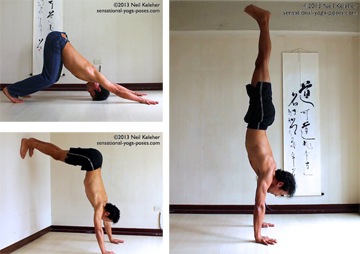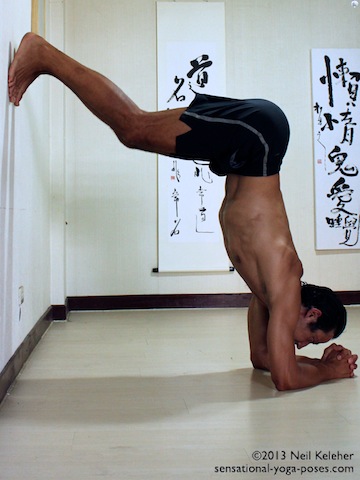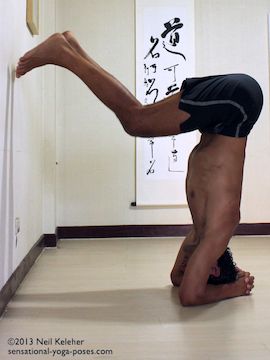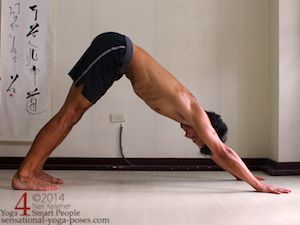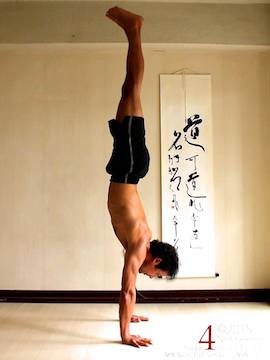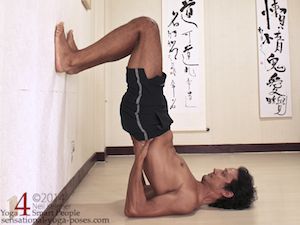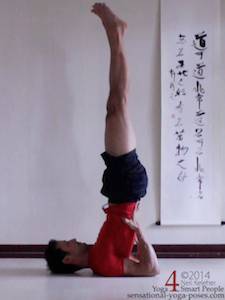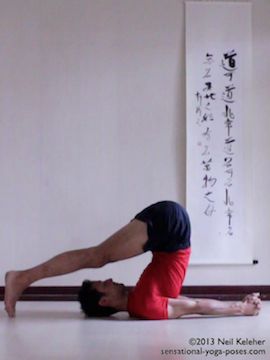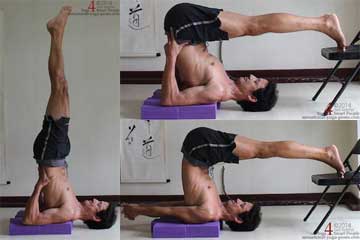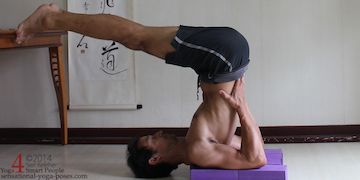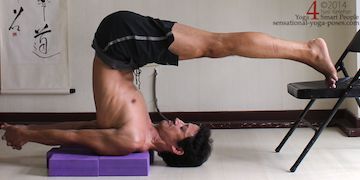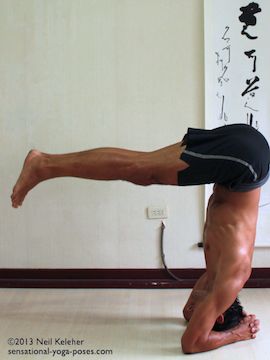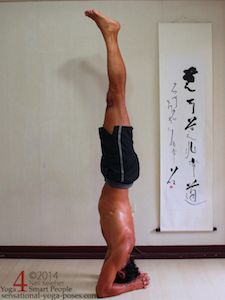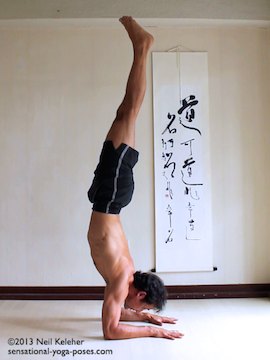Inverted Yoga Poses Index
One of the first things that you can work on prior to doing any inverted yoga pose is shoulder stability.
That can start with working on scapular awareness.
In most inverted yoga poses you are using your shoulders to support the weight of your body, so even before you get upside down, first learn how to stabilize your shoulder blades with respect to your ribcage.
Another alternative for creating arm stability for inverted poses is to work from the ground up. With inversions like handstand that can mean activating the fingers to stabilize hand and wrist and also activating the elbows to prevent rotation of the arms.
Once you have learned to stabilize your shoulder blades, first without weight and then with weight, you can then get used to getting upside down gradually by using a wall to support yourself.
The idea at this point isn't to balance, but to get used to being upside down.
And so that you overcome the fear of being upside down, first just practice going up and then down without trying to hold the upside down position.
Simply practicing going up and coming down can help you get over any fear. It also helps you to develop the control necessary to help you stay up in the pose.
Getting Used to Being Upside Down Before You Worry About Balance
Once you are used to being upside down, you can then do the necessary exercises so that you can work towards balancing while upside down.
But Why Go Upside Down in the First Place
So why go upside down?
- A student told me that she likes to do headstand first thing in the morning to help her wake up. She thinks it's preferable to drinking coffee. And that can be one reason to practice going upside down, to wake yourself up.
- Another reason (and this may lead to the first) is that going upside down flips the tension in your body. You'll be making your heart (and other muscles) work harder to pump blood up to your legs. And as a result you may also find that you get a rush of blood to the head. And so that is something to be aware of both while doing inverted yoga poses and when coming out of them. (You may feel momentarily dizzy, especially if you try to stand up too quickly.
- Another reason is that it teaches you better control of your body. If you can control your body upside down, you are much more likely to have better control while upright.
Dealing with fear
Perhaps one of the biggest challenges when doing free standing inverted yoga poses (i.e. moving away from the wall) is dealing with fear. Fear can be a good thing. It reminds us when we need to take care. So the question is, how do you take care? And what can you do to make the situation you are fearful of as safe as possible? Read dealing with fear to find out more.
Working towards a yoga inversion like handstand you can start off in downward facing dog.
Once you've gotten used to bearing some of your body weight with your hands and shoulders in downward dog, you can then work towards supporting more of your weight with your arms while doing handstand with your feet on the wall in an L-Shaped handstand.
The beauty of this inverted yoga pose is that the wall can take some of your weight.
Since the serratus anterior are a key stabilizing muscle for the scapula in postures like downward dog, handstand, headstand and forearm stand, you could develop a sequence of postures that start with you getting used to using your serratus first with the arms not supporting weight and then in poses where the arms support more and more weight.
Now while a lot of yoga teachers may suggest getting your torso vertical and over your hands in this position, since in handstand that's what you are also supposed to do, I'd suggest that instead you find a position where it is easy to support your weight.
Once you are comfortable in L-shaped handstand, then you can work on kicking up into handstand and here again you can work towards kicking up into this inverted yoga pose gradually.
You can work at using one leg and then the other and then you can work at using them both together. The nice thing about kicking up is that it makes it relatively easy to get up into this yoga pose. Then you can focus on balancing in handstand.
You then might want to experiment with the double leg jump into handstand.
In this action you kick up while keeping your feet together as opposed to scissoring them. Here again you can work towards getting up gradually, each time adding a little bit more power to your kicks.
For tips on how to stabilize and what, check out handstands.
You can then work on pulling up or lifting up into handstand from there.
Take Your Time
The most important thing is to proceed slowly so that you feel comfortable at each stage of this yoga inversion and so that you can feel your body and control it as necessary at each stage.
Working Towards Other Inverted Yoga Poses
Other yoga inversions that you can work towards using a wall include headstand, shoulderstand, and pincha mayurasana or forearm stand.
Shoulder Stand could be considered one of the easier inverted yoga poses because your base is so big. However it can be difficult to get into especially if neck flexibility is limited and or you have weak abdominals. And so using a wall to get into shoulder stand is a good way to get started.
To use a wall when doing shoulder stand, start with your legs up the wall and scootch close so that your but is also against the wall.
Then bend your knees and use your feet against the wall to lift your pelvis off of the floor.
As you get your pelvis higher you can then work at getting your shoulder blades closer together to help lift the base of the back of your neck off of the floor.
As with all other inverted yoga poses, work slowly and gradually, proceed step by step and learn to feel your body and control it every step of the way.
Once you are used to getting up and down using a wall you can try rolling into shoulder stand or salamba sarvangasana as it is also known.
A pose that is often used before or after shoulder stand is plough pose (or halasana) since it uses a similiar foundation.
Generally it is used before shoulderstand to help set up the shoulders (clasping the hands to wiggle the shoulder blades together.) However if you have good shoulder mobility you can wiggle your shoulder blades closer while you legs are up in the air in shoulderstand. Then you can move into plough pose afterwards.
Options for Shoulderstand And Plough When You Have a Tight Neck
If the back of your neck is very tight, limiting your ability to bend your neck forwards then one way to get around this limitation in both shoulderstand and plough pose is to use a set of yoga blocks to elevate the upper arms and shoulders while allowing the head to hang over the edge.
For shoulderstand and plough pose I used 8 blocks, wide enough for my shoulders from side to side and wide enough for my upper arms from front to back.
You could possibly get away with six blocks, just set them up with gaps inbetween.
Lay on the blocks so that your head can hang down onto the floor. Then press your elbows into the blocks to lift your legs up off of the floor.
If you have difficulty lifting your legs you try doing shoulderstand in front of a wall (with butt closer to the wall than your head.) With the neck out of the way, (without neck flexibility being a limit) it is then fairly easy to make the torso vertical and the legs vertical also.
If hamstring flexibility is limited but you want to do plough pose then set up a chair behind you (or do it in front of a table.) reach your legs back and place them on the chair or table.
For headstand one of the first considerations since your neck could be under a lot of pressure is learning to use your shoulders to help create a solid base.
In addition, while in this inverted yoga pose you can use your shoulders to help you balance. How? By consciously using them to vary the pressure of your elbows on the floor.
If you are already pretty comfortable with headstand using a wall here are some guidelines for getting into headstand with legs straight.
Forearm stand (pincha mayurasana) could be used as a substitute for headstand is forearm stand.
The poses are similiar in that the forearms are on the floor, however in pincha-mayurasana the hands are separated and the head is off the floor.
This inverted yoga pose may require a bit more flexibility in the shoulders and chest. Usually I use some shoulder stretches prior to actually having my students try the pose. As well, since the forearms are used to support the weight of the body, dolphin yoga pose could also be used as a preparation or as an inverted pose (or semi-inverted pose) in its own right.
Balancing In Inverted Yoga Poses
Once you are comfortable being upside down in any inverted yoga pose, you can then work towards balancing in that yoga pose. Here's some tips for
To make balancing in headstand easier make sure that you use your shoulders to push your elbows into the floor.
Focus on keeping your weight midway between your elbows and head.
You won't be quite vertical but once you can hold this position, and get in and out of it comfortably then you can work towards balancing with all your weight on the crown of your head.
For shoulder stand you again press your elbows into the floor. You can have your weight between elbows and hands but as you get more comfortably you might try shifting your weight so that it is centered over your shoulders. Remember to keep your shoulder blades squeezed towards each other.
For Handstand, you can focus on using your hands to feel your center of gravity. Anytime you notice a shift (via your hands, counter act that shift so that you stay balanced. That can mean using your fingers, moving your shoulders, your hips, or your legs.
For more on balance check out yoga balance poses and/or the balance basics ebook.
What to Do After an Inverted Yoga Pose
In yoga there is the idea of counterposes. These help to bring the body back to a "balanced" state. This can be no less true with inverted yoga poses. You can do these before the inversion or after as I mention below.
Since bound headstand, handstand and forearm stand are all positions in which the arms are in an "over head" position, a good counterpose for the shoulders is an arms behind the back pose. And so you could do
- forward bend with hands clasped behind the back letting your arms sink down,
or do a yoga pose like
- bridge
- table top
- reverse plank.
Note that the most usual counterpose for headstand is shoulderstand.
You could do these counterposes before headstand. In the ashtanga system shoulderstand is done before headstand. In other yoga schools shoulderstand is done after headstand.
Resting after Inversions
Another idea is to rest after doing a challenging inversion. Andrey Lappa suggests sitting upright after inversions. This can give your chance to "center itself" and it is also a chance for you to notice the after effects of a pose. If you just need to rest then child's pose is also an option, particularly after headstand.
For more on Shoulder Awareness check out my ebook
Yoga For Your Shoulders (available in mobi, epub and pdf)
Published: 2011 11 11
Updated: 2021 01 24
